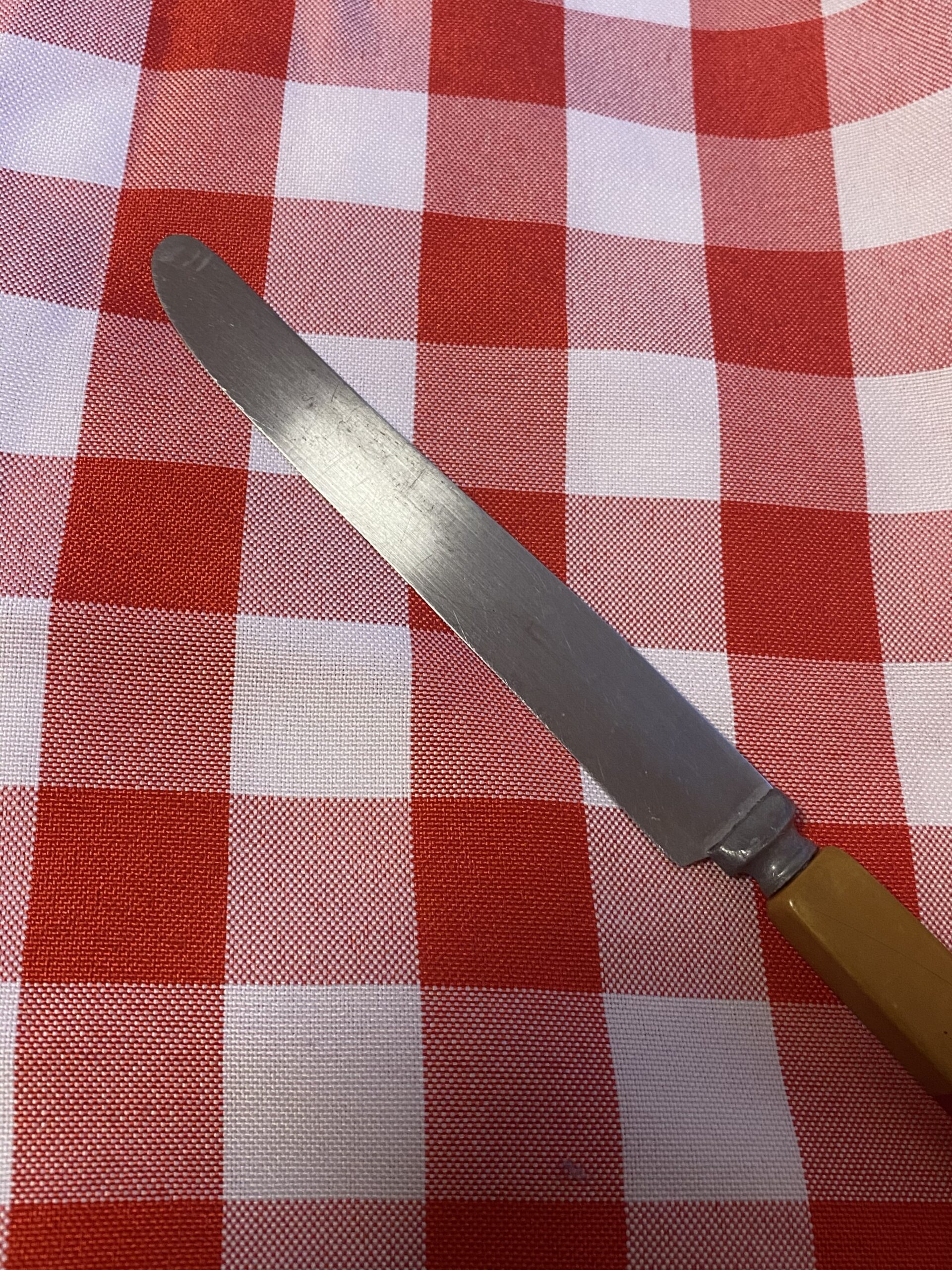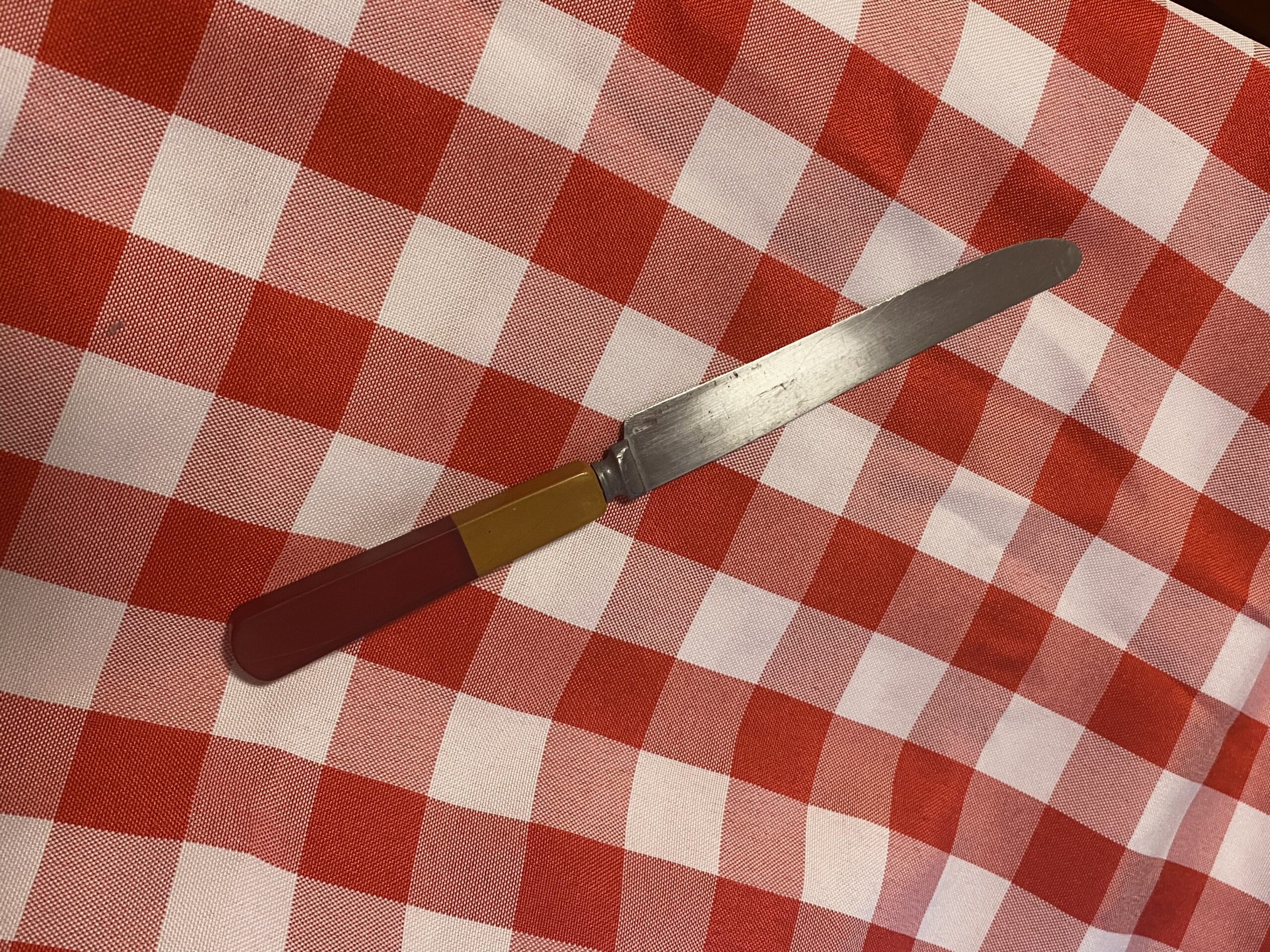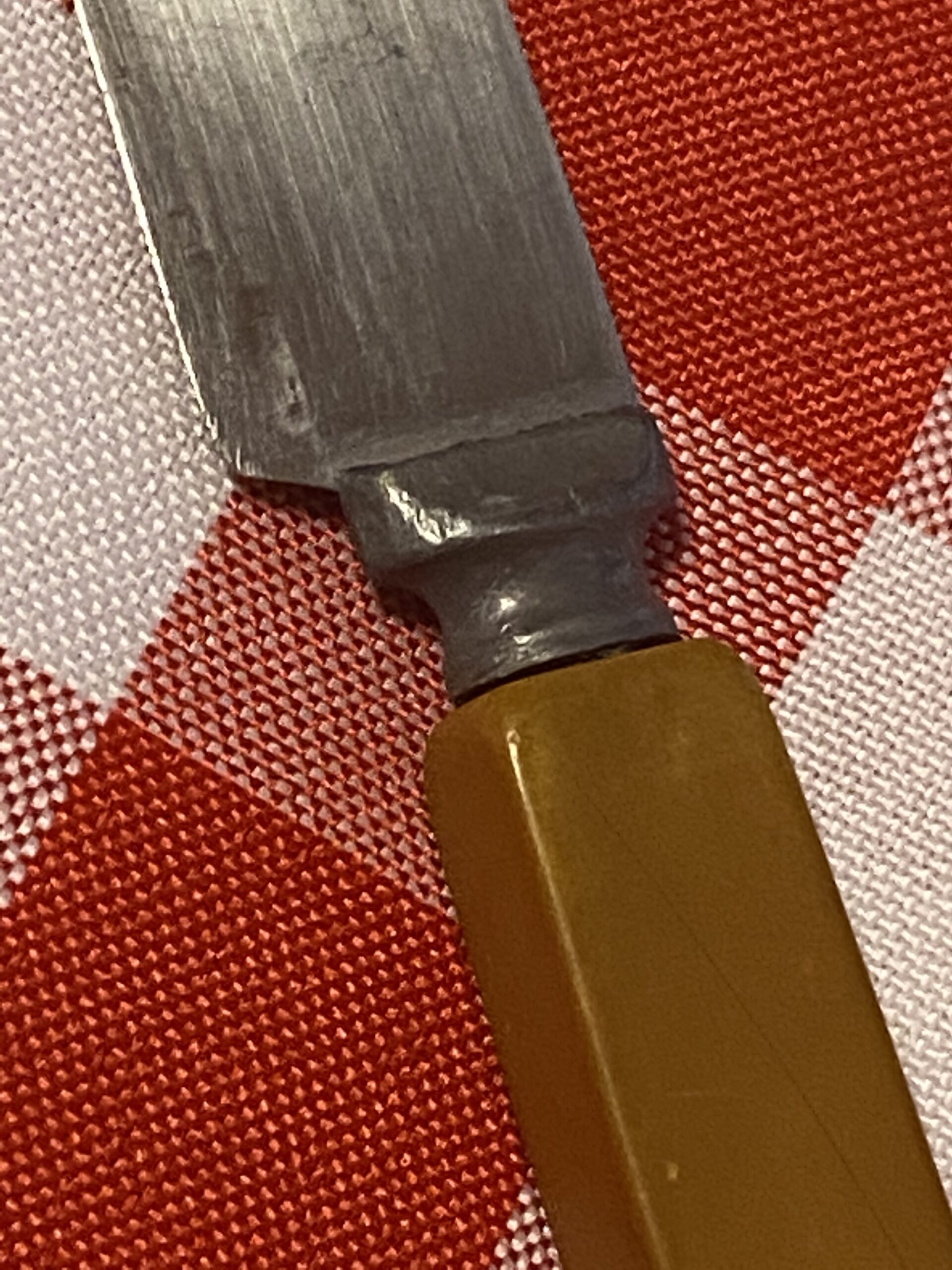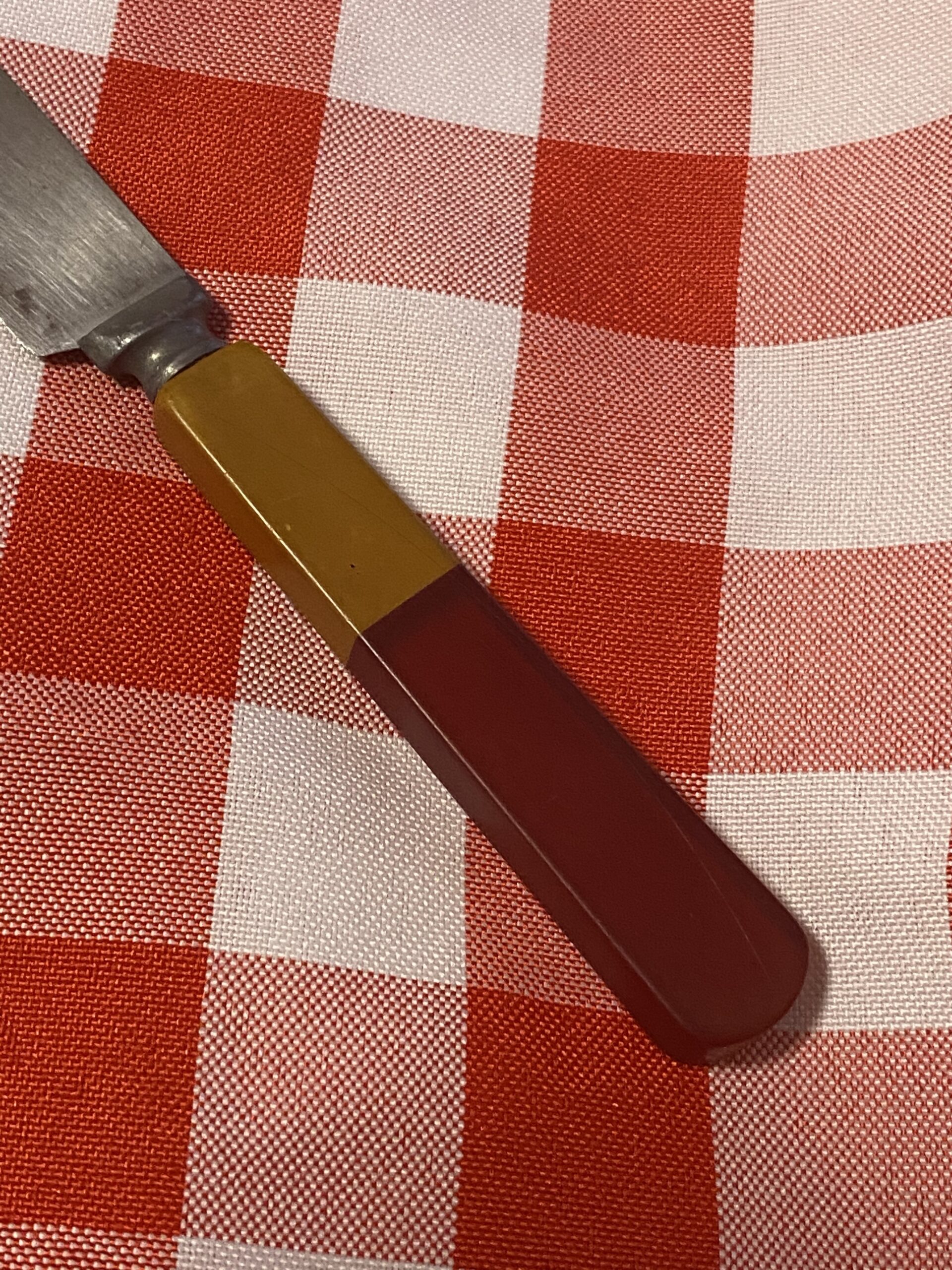Vintage dinner knife with red and yellow Bakelite handle — 760,500 ppm Lead in the join point
For those new to this website:
Tamara Rubin is a multiple-federal-award-winning independent advocate for childhood Lead poisoning prevention and consumer goods safety and a documentary filmmaker. She is also a mother of Lead-poisoned children (two of her sons were acutely Lead-poisoned in 2005). Since 2009, Tamara has been using XRF technology (a scientific method used by the U.S. Consumer Product Safety Commission) to test consumer goods for toxicants (specifically heavy metals — including Lead, Cadmium, Mercury, Antimony, and Arsenic). Tamara’s work was featured in Consumer Reports Magazine in February of 2023 (March 2023 print edition).
19, 2021 — Monday
I picked up this “souvenir” when helping a family review the items in their home (so they could remove potentially-toxic things and prevent any possible Lead exposure for their children). Sometimes when I go to a home and find a really good example of something I do not yet have up on my website (or in my collection of Leaded items), I ask if they will give it to me so I can do a complete series of tests and write up an article to share with others on the site. This knife is actually an excellent example of something I talk about quite a bit in my work with families.
It’s almost always material-transitions (e.g. a handle/blade joint) that are a concern in potentially-toxic knives (& other flatware.)
In general, I don’t have a concern for kitchen knives (from a Lead perspective). An exception to this is when the knife is constructed of more than one material, such as when metal of the blade of the knife is obviously made of a different material than the handle of the knife. Lead can present itself in many different scenarios, including with sterling Silver knives (in which both materials are metal – but different metals: the handle is usually sterling, but the blade is normally stainless), and even in knives that look like they are made of the same metal throughout (for example – with a stainless blade and a stainless handle — but have a join seam of a slightly different-colored metal.
While sometimes it can be hard to tell if the components of a knife are made of different materials or not – In this case (with the knife pictured here), it is a shockingly obvious concern — as the hard plastic Bakelite (which also separately tested positive for Lead) is attached to the metal of the blade with what literally amounts to a hunk of nearly-solid Lead (with some Antimony – also highly toxic – and Tin thrown in for good measure).
If you have a knife (or other vintage flatware or serving pieces) with a gray metal join point like this (or something similar) please stop using it for food use purposes and please consider throwing the set out (even breaking them before disposing of them, so they can never be used by another family). The metal component of the handle of this knife will normally also test positive with a LeadCheck swab (as the component is nearly solid Lead) and I will be making a video to show that shortly (so subscribe to the Lead Safe Mama YouTube Channel if you want to be among the first to see that!)
Note: nearly solid Lead join points can also be found in vintage/antique sterling silver baby cups (where the handle is attached to the cup.) These spots will also test positive with a swab and if your vintage/antique silver baby cup handle is attached with Leaded solder it should not be considered safe for children to use. I also see bare/exposed leaded solder at the attachment points of the handles on MOST (but not all) copper “Moscow Mule” mugs. In addition to high Lead solder being used to attach the handles to these cups, the handles on these mugs are also traditionally very high-Lead brass (approximately 30,000 to 40,000 ppm Lead normally.)
Takeaway:
Look for flatware that is all-stainless in construction – or at least that does not have an obvious join point made up of what may be mixed metals (or possibly Lead-contaminated solder, as is often found with vintage or antique sterling silver flatware). Here’s a link to a good (likely Lead-free) flatware set on Amazon*: https://amzn.to/2VYFIgV I will be publishing more safe (likely Lead-free) flatware choices shortly on www.ShopLeadSafeMama.com.
Continue reading below the image of the join point of this knife.
Full XRF Test Results for the Knife Pictured
#1.) Metal blade of knife
30-second test: Stainless Steel 416
- Bromine (Br): 20 +/- 9 ppm
- Chromium (Cr): 122,800 +/- 600 ppm
- Vanadium (V): 378 +/- 124 ppm
- Manganese (Mn): 4,803 +/- 433 ppm
- Iron (Fe): 868,600 +/- 1,000 ppm
- Nickel (Ni): 1,464 +/- 186 ppm
- Copper (Cu): 946 +/- 109 ppm
- Zinc (Zn): 98 +/- 36 ppm
- Molybdenum (Mo): 740 +/- 57 ppm
- Tin (Sn): 72 +/- 16 ppm
#2.) Gray metal join point of knife (joining handle to blade)
60-second test
- Lead (Pb): 760,500 +/- 1,300 ppm
- Bromine (Br): 127 +/- 35 ppm
- Chromium (Cr): 5,863 +/- 471 ppm
- Iron (Fe): 12,700 +/- 400 ppm
- Copper (Cu): 2,023 +/- 109 ppm
- Selenium (Se): 331 +/- 151 ppm
- Titanium (Ti): 3,156 +/- 1,063 ppm
- Zirconium (Zr): 296 +/- 56 ppm
- Niobium (Nb): 378 +/- 61 ppm
- Tin (Sn): 101,900 +/- 500
- Antimony (Sb): 110,500 +/- 500 ppm
- Barium (Ba): 1,212 +/- 206 ppm
- Tungsten (W): 1,044 +/- 314 ppm
#3.) Yellow bakelite handle
60-second test
- Lead (Pb): 2,804 +/- 16 ppm
- Bromine (Br): 41 +/- 1 ppm
- Chromium (Cr): 55 +/- 13 ppm
- Iron (Fe): 100 +/- 7 ppm
- Nickel (Ni): 5 +/- 3 ppm
- Copper (Cu): 55 +/- 3 ppm
- Zinc (Zn): 3+/- 2 ppm
- Tin (Sn): 428 +/- 7 ppm
- Antimony (Sb): 395 +/- 7 ppm
- Barium (Ba): 55 +/- 28 ppm
- Gold (Au): 9 +/- 2 ppm
- Bismuth (Bi): 14 +/- 5 ppm
#4.) Red bakelite handle
30-second test
- Iron (Fe): 28 +/- 8 ppm
- Copper (Cu): 6 +/- 3 ppm
- Barium (Ba): 97 +/- 42 ppm
Some additional reading that might be of interest:
- The article discussing the testing methodology used on this website
- An article discussing how to send in an item for testing
- My “Silverware” overview article — with links to all of the silverware examples and test results here on the website.
- “Can I test these myself at home?”
Thanks for reading. Thank you for sharing this work. As always, please let me know if you have any questions and I will do my best to answer them personally as soon as I have a moment (which may not be right away — but I will try!)
Tamara Rubin
#LeadSafeMama
Amazon links are affiliate links. If you purchase something after clicking on one of my links I may receive a percentage of what you spend — at no extra cost to you.

Never Miss an Important Article Again!
Join our Email List













This was our silverware brand that poisoned my children. I used it 24/7. I had the whole set.